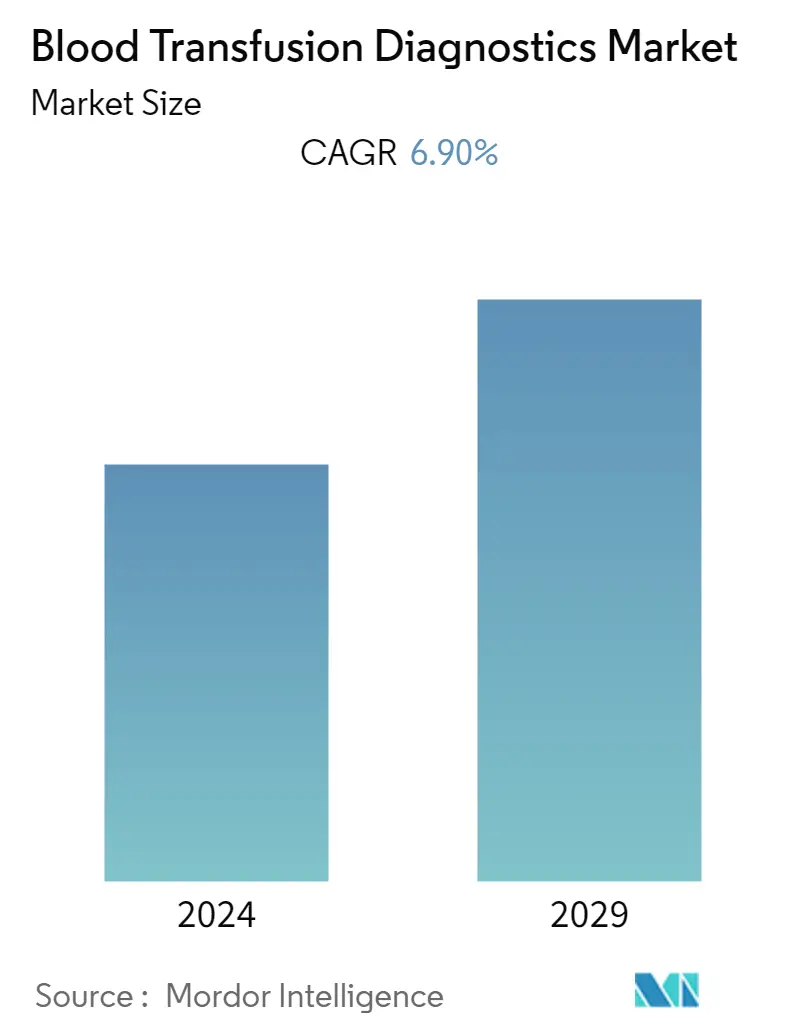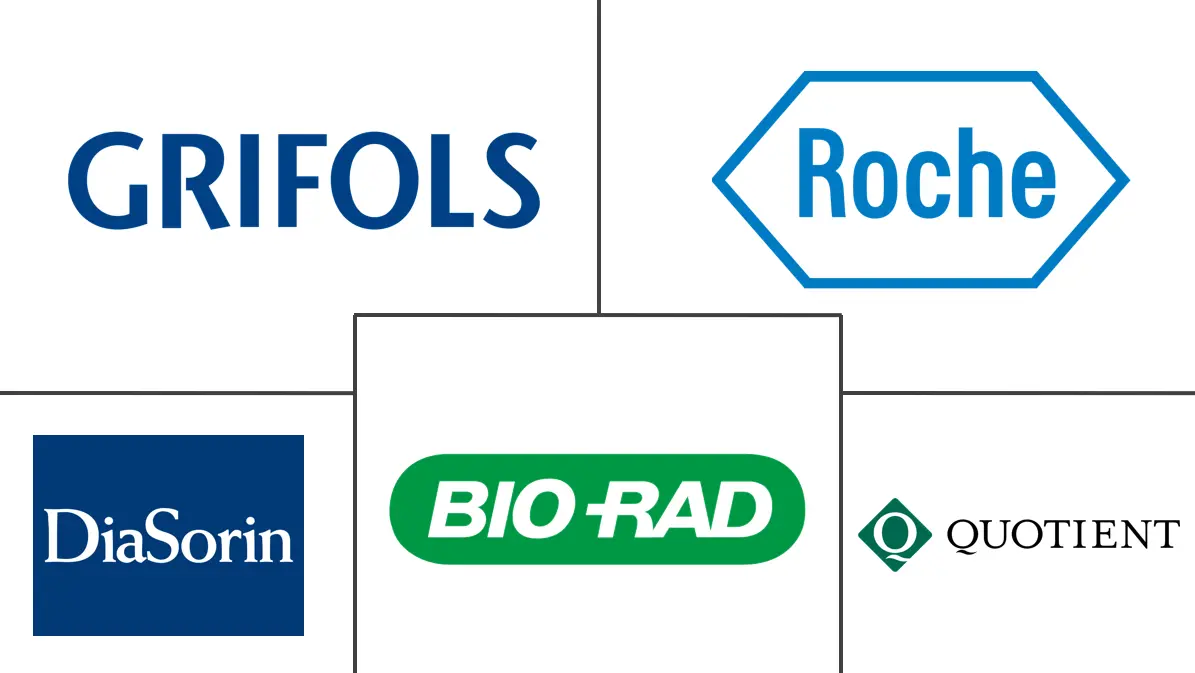
| Study Period | 2019 - 2029 |
| Base Year For Estimation | 2023 |
| Forecast Data Period | 2024 - 2029 |
| CAGR | 6.90 % |
| Fastest Growing Market | Asia-Pacific |
| Largest Market | North America |
| Market Concentration | High |
Major Players
*Disclaimer: Major Players sorted in no particular order |
Blood Transfusion Diagnostics Market Analysis
The Blood Transfusion Diagnostics Market is expected to register a CAGR of 6.9% over the forecast period.
The COVID-19 pandemic has significantly impacted the blood transfusion diagnostics market throughout the year. Strict regulation, social distancing, home quarantine, and other restrictions significantly impacted the blood donation and blood collection procedures. This resulted in a decreased amount of blood transfusion. For instance, according to American Red Cross, in March 2020, it was reported that a severe blood crisis was there owing to a huge number of blood donation drive cancellations for the COVID-19 outbreak which resulted in 86,000 fewer blood donations. Also, according to a research article by NCBI in March 2022, it was reported that active and inactive donors both were reluctant to donate blood which significantly impacted the overall blood donation intention. This alternatively decreased the need for transfusion diagnostic and hindered the adoption of transfusion diagnostic kits and other instruments. Apart from that, owing to relocating medical staff and lab technicians to the COVID-19 department, there was a shortage of healthcare professionals for blood transfusion diagnostics during the pandemic. This resulted in the slowdown of blood transfusion diagnostics procedures. However, in the post-pandemic situation, a thrive was observed for blood donation to diminish the effect of the pandemic. This alternatively offsets the impact of blood shortage and normalizes the situation for blood transfusion.
Further, the increasing prevalence of blood-related disorders, including hemophilia, thrombocytopenia, and other disorders, is increasing the demand for blood transfusion. This, in turn, is increasing the demand and adoption of blood transfusion diagnostics. For instance, according to an article published by Medscape on March 2022, it was reported that the prevalence of Hemophilia A is 20.6 cases per 100,000 males in the United States. Also, according to an article published by the Canadian Hemophilia Society (CHS) in February 2022, it was reported that the total number of Canadian suffering from Hemophilia A and B is estimated to be 3,100. Thus, the rising prevalence of blood-related disorders propels the demand and adoption of blood transfusion diagnostic products during the study period.
Moreover, the rising initiatives by the for-profit and not-for-profit organizations to increase blood donation awareness positively impact the market growth. For instance, according to a press release by the U.S. Department of Health & Human Services on August 2022, it was reported that the U.S. Department of Health and Human Services (HHS) announced a campaign to increase awareness of donating blood and plasma. Also, in October 2022, NHS Blood and Transplant introduced a sickle cell blood donation campaign to increase the number of blood donors for sickle cell anemia. Thus, an increasing number of awareness campaigns on blood donation and transfusion is alternatively increasing the demand for blood transfusion diagnostic products and fueling the market growth.
Therefore, due to the above factors, the market is anticipated to grow substantially during the study period. However, certain factors, including adverse reactions during the blood transfusion procedure, limit the market's growth to some extent.
Blood Transfusion Diagnostics Industry Segmentation
As per the scope of the report, Blood Transfusion Diagnostics instruments and consumables are mainly used prior to the transfusion procedure to eliminate the risk of adverse reactions and disease transmission.
The Blood Transfusion Diagnostics Market is segmented by Product Type (Instruments and Reagents & Kits), Application (Blood Grouping and Disease Screening), End-User (Hospitals, Diagnostics Laboratories, Blood Banks, and Others), and Geography (North America, Europe, Asia-Pacific, Middle East, and Africa, and South America). The market report also covers the estimated market sizes and trends for 17 different countries across major regions globally. The report offers the value (USD million) for the above segments.
| Instruments |
| Consumables |
| Blood Screening |
| Blood Group Typing |
| Hospitals |
| Diagnostics Laboratories |
| Blood Banks |
| North America | United States |
| Canada | |
| Mexico | |
| Europe | Germany |
| United Kingdom | |
| France | |
| Italy | |
| Spain | |
| Rest of Europe | |
| Asia-Pacific | China |
| Japan | |
| India | |
| Australia | |
| South Korea | |
| Rest of Asia-Pacific | |
| Middle-East and Africa | GCC |
| South Africa | |
| Rest of Middle East and Africa | |
| South America | Brazil |
| Argentina | |
| Rest of South America |
Blood Transfusion Diagnostics Market Size Summary
The Blood Transfusion Diagnostics Market is poised for significant growth, driven by the increasing prevalence of blood-related disorders such as hemophilia and thrombocytopenia. The market experienced disruptions during the COVID-19 pandemic due to restrictions on blood donation and a shortage of healthcare professionals, which temporarily hindered the adoption of transfusion diagnostic kits and instruments. However, post-pandemic recovery has seen a resurgence in blood donation efforts, helping to normalize the market. The demand for blood transfusion diagnostics is further bolstered by initiatives from both for-profit and not-for-profit organizations aimed at raising awareness about blood donation. These efforts are expected to fuel market growth, despite challenges such as adverse reactions during transfusion procedures.
The market is characterized by a strong focus on consumables, particularly reagents and kits, which are favored due to their repeated use and lower cost compared to instruments. North America is anticipated to dominate the market, supported by advanced healthcare facilities and a high awareness of blood transfusion needs. The region's significant patient population with disorders like anemia and sickle cell anemia drives the demand for transfusion diagnostics. The competitive landscape is consolidated, with key players such as Grifols, S.A., F. Hoffmann-La Roche Ltd., and Immucor, Inc. actively expanding their product offerings through strategic partnerships and acquisitions. These dynamics are expected to shape the market's trajectory over the forecast period.
Blood Transfusion Diagnostics Market Size - Table of Contents
1. MARKET DYNAMICS
- 1.1 Market Overview
-
1.2 Market Drivers
- 1.2.1 Increasing Number of Blood Related Disorders
- 1.2.2 Technological Advancement in the Blood Testing Kits and Assays
-
1.3 Market Restraints
- 1.3.1 Certain Adverse Reaction Associated with the Procedure
-
1.4 Porter's Five Force Analysis
- 1.4.1 Threat of New Entrants
- 1.4.2 Bargaining Power of Buyers/Consumers
- 1.4.3 Bargaining Power of Suppliers
- 1.4.4 Threat of Substitute Products
- 1.4.5 Intensity of Competitive Rivalry
2. MARKET SEGMENTATION (Market Size by Value - USD million)
-
2.1 By Type
- 2.1.1 Instruments
- 2.1.2 Consumables
-
2.2 By Application
- 2.2.1 Blood Screening
- 2.2.2 Blood Group Typing
-
2.3 By End-User
- 2.3.1 Hospitals
- 2.3.2 Diagnostics Laboratories
- 2.3.3 Blood Banks
-
2.4 Geography
- 2.4.1 North America
- 2.4.1.1 United States
- 2.4.1.2 Canada
- 2.4.1.3 Mexico
- 2.4.2 Europe
- 2.4.2.1 Germany
- 2.4.2.2 United Kingdom
- 2.4.2.3 France
- 2.4.2.4 Italy
- 2.4.2.5 Spain
- 2.4.2.6 Rest of Europe
- 2.4.3 Asia-Pacific
- 2.4.3.1 China
- 2.4.3.2 Japan
- 2.4.3.3 India
- 2.4.3.4 Australia
- 2.4.3.5 South Korea
- 2.4.3.6 Rest of Asia-Pacific
- 2.4.4 Middle-East and Africa
- 2.4.4.1 GCC
- 2.4.4.2 South Africa
- 2.4.4.3 Rest of Middle East and Africa
- 2.4.5 South America
- 2.4.5.1 Brazil
- 2.4.5.2 Argentina
- 2.4.5.3 Rest of South America
Blood Transfusion Diagnostics Market Research FAQs
What is the current Blood Transfusion Diagnostics Market size?
The Blood Transfusion Diagnostics Market is projected to register a CAGR of 6.9% during the forecast period (2025-2030)
Who are the key players in Blood Transfusion Diagnostics Market?
Grifols, S.A., F. Hoffmann-La Roche Ltd., Diasorin S.p.A, Bio-Rad Laboratories, Inc. and Quotient Suisse SA are the major companies operating in the Blood Transfusion Diagnostics Market.


